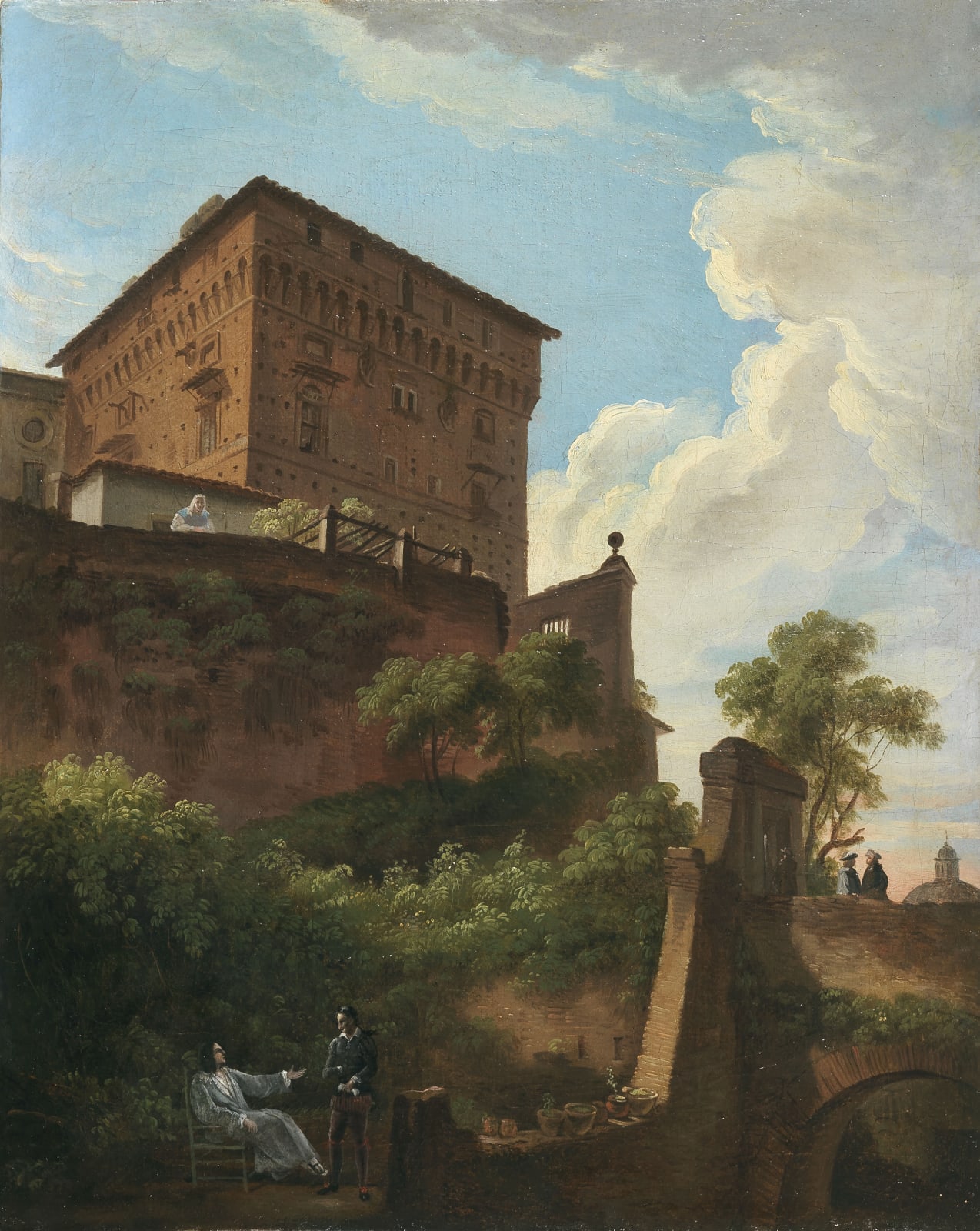Jean Antoine CONSTANTIN D’AIX 1756-1844
Provenance
Collection Thierry de Chirée, Avignon
The work of Constantin D’Aix, although undated, belongs to the Roman periodo f the artist, because it maintains the bucolic and picturesque atmosphere of many of his landscapes. The diffuse light and lush vegetation are mixed here cleverly with both the architectural element with the human one.
The upper part of the composition is dominated by the tower of Paul III Farnese on the Capitoline Hill, one of the many monuments of the ‘disappeared Rome’.
It was built on the Capitol by the pope from which it takes its name, in the years 1534-1542 by the architect Jacopo Melenghino: the tower observatory was the tallest building in Rome, after the Senatorial Palace.
Between 1885 and 1888, to erect the “Vittoriano”, there were many evictions and demolitions in the area adjacent to the Capitol: they were demolished (in addition to the tower depicted in the paintings), the Arch S. Marco (the overpass connecting with “Palazzo Venezia”), the three cloisters of the convent of Aracoeli, and all the other buildings present on the hill.
The paintings comes from the collection of Thierry and Christine de Chirée, one of the richest and most prestigious private collections in France, where the works of Constantin D’Aix occupy a prominent place: in fact there were in the collection numerous drawings and oil paintings of the artisti, such as the one presented here.
Prestigious was also the place in which the collection was presented: the “Monastery of the Visitation” in Avignon, purchased by the owners to make it their home in 1993, by the sisters of the Blessed Sacrament Which, following the sale of other two monasteries, they decided to sell the complex. The Chapel of the Visitation and the convent buildings were classified ‘Historical Monuments’ in 1932 and 1988. After the purchase by Thierry and Christine major works were executed, culminating with the restoration of the great library and the west gallery of the cloister.
The collecting passion of Thierry de Chirée began almost by chance in 1979 with the purchase of a design at one of the many galleries in Paris. Key figures in the development of the collection were: the friend Marcel Puech (another superfine collector), which was an important guide for the amateur from the start; Turquin Eric, whose advice persuaded Thierry to add paintings in his collection, and finally Jean Dorlhac, who made the collection enriched with rare objects, sculptures and antique furniture.
Today we can see the Chirée collection’s pieces at the Getty Museum and the County Museum of the Art in Los Angeles, at the museums of San Francisco, Washington and at the Louvre of Paris.
Jean-Antoine Constantin, better known by the name of Constantin D’Aix, was a talented watercolour painter and engraver, and is considered one of the fathers of modern Provençal painting.
He was born in 1756 in the district of Louviere, near the town of Bonneveine, and after a short apprenticeship at the porcelain factory of Joseph-Gaspard Robert, studied at “Academy of Painting and Sculpture” in Marseille, where he had the opportunity to follow courses of David de Marseille, Jean-Joseph Kapeller and Jean-Baptiste Giry.
In 1773 he moved to Aix, where some patrons, fascinated by his art, offered him a training stay in Rome. Here, where the remains for only three years due to a virus that will force him to return to his native land, he completed his artistic education under the guide of Joseph Vien.
The years spent in the ‘Eternal City’ were very important for his life. The beauty of the landscapes, the light of the city, the quiet of the Roman countryside represented an inexhaustible source of inspiration.
In France he will apply one-self to painting and teaching, living and working primarily in Aix-en-Provence, where he will conduct between 1786 and 1792 the school of art.
Although his career has been continually hampered by health problems and economic difficulties, he arrived at the age of 88 years, leaving many works, almost all made in the second part of his life (among prizes, there is the prestigious Gold Medal won in 1817 at the Paris Exposition).
So the painter François Marius Granet, one of his students, speaks to his colleague Augustine de Forbin: “He will always be our teacher. We are not worthy even to tie his shoelaces.”
JOIN OUR MAILING LIST
Subscribe to our mailing list in order to receive news on new acquisitions, exhibitions, special previews and more!
* denotes required fields
We will process the personal data you have supplied to communicate with you in accordance with our Privacy Policy. You can unsubscribe or change your preferences at any time by clicking the link in our emails.
